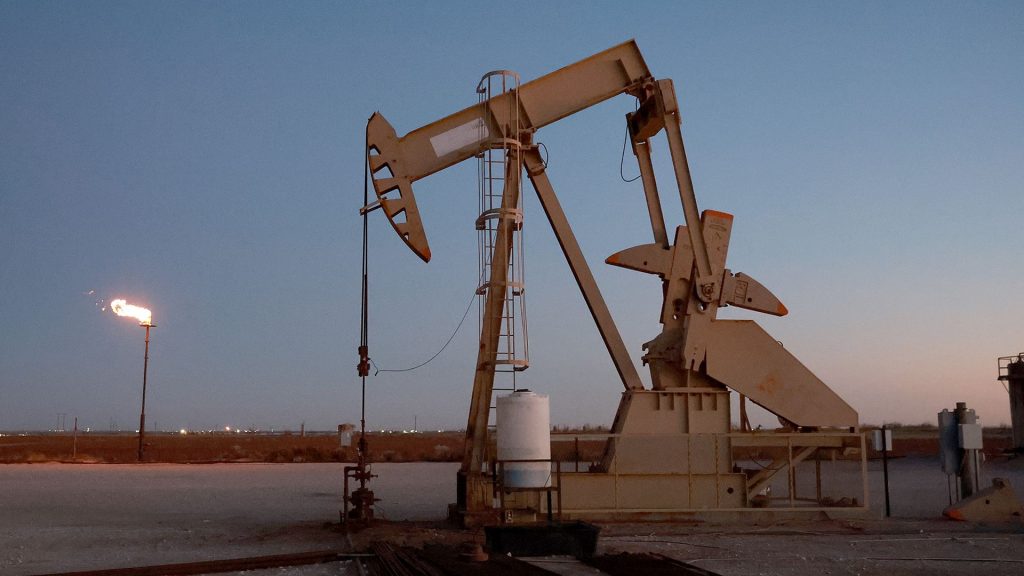Trump’s push for cheap gas and ‘drill, baby, drill’ are at odds, experts say

Both on the campaign trail and in the White House, President Donald Trump has repeated two oil policy goals: allowing U.S. oil and gas companies to “drill, baby drill” and lowering consumer costs at the gas pump. The problem, according to experts who study oil markets, is that the low oil prices that translate to cheap gasoline will disincentivize oil companies to expand drilling.
On his first day in office this January, Trump signed an executive order, “Unleashing American Energy,” eliminating about a dozen executive orders signed by President Joe Biden. The order describes how “high energy costs devastate American consumers” and calls to “unleash America’s affordable and reliable energy and natural resources.”
Throughout the summer, the White House has cited low gas prices as proof that Trump is fulfilling promises to voters. Although Trump has falsely claimed that gas costs $2 in some states, prices are down from heights in 2022, and may reach a national average below $3, Reuters reported.
The current national average is $3.10 per gallon, with Mississippi boasting the least expensive gas at $2.50 in one county, according to data from GasBuddy.
How are crude oil and gasoline prices related?
Patrick De Haan, head of petroleum analysis at GasBuddy, said, “there’s a pretty solid direct relationship between the price of oil and gasoline,” as long as refineries that turn crude oil into gasoline operate smoothly.
More than half of the cost of gasoline — 53% according to the U.S. Energy Information Administration — goes toward crude oil. The rest goes toward state and federal taxes, marketing, distribution, refining and the seller’s profit margin.
The last time gasoline hit an average of $2 per gallon was in June of 2020, when the price of crude oil was $38 per barrel. A Goldman Sachs analysis determined Trump’s preferred price for oil is $40 or $50 per barrel — a price at odds with what oil and gas drilling and exploration companies need to profit from expanded production.
“Its going to be hard to convince oil companies to ‘drill, baby drill’ at $50 a barrel,” said Skip York, a nonresident fellow at the Center for Energy Studies at Rice University’s Baker Institute.
What’s going on in the global oil market?
Globally, oil demand is expected to slow compared to the previous decade. The International Energy Agency expects global demand to peak around the end of the decade.
Demand in China, the world’s largest consumer, may peak even sooner. China is shifting to electric vehicles faster than anywhere else in the world, reducing the country’s oil needs. While experts do not all agree on how soon demand will peak, or how fast it will decline, the overall trend is generally undisputed.
At the same time that demand is projected to stagnate, oil supply is growing, as Saudi Arabia and other OPEC countries reverse production cuts that had been in place for several years. In June, Saudi Arabia increased its production by 400,000 barrels per day compared to May. The Saudi Kingdom is now pumping nearly 10 million barrels per day, with more increases expected through the rest of the year.
U.S. producers are “seeing the writing on the wall,” said Kannan Ramaswamy, a professor in global business at Arizona State University, in an interview with Straight Arrow News.
What oil price do US companies want?
In the Federal Reserve Bank of Dallas’ quarterly survey of executives from oil production and exploration companies, 42% of executives from large firms reported that the number of wells they expect to drill in the next year has decreased significantly, compared to their initial forecasts. None of the large firms expect a significant increase, and another 33% are anticipating a slight decrease in the number of wells they will drill in the next year.
According to York, before the pandemic, the market favored companies that expanded production; now, shareholders prefer dividends, reaping the rewards of previous expansions, rather than investing in further growth.
“The market now rewards for value, not for volume,” York told SAN.
Unbiased. Straight Facts.TM
71% of large U.S. oil companies said they would have to decrease drilling if crude oil costs $60 per barrel, according to a Dallas Fed survey.

The Dallas Fed survey also revealed oil producers’ price sensitivity. If prices stay at $60 per barrel over the next year, 71% of large exploration and production firms said they would either significantly or slightly decrease production compared to June 2025. The share rises to 93% if the price dips to $50 per barrel.
Most companies need to see the price above $75 per barrel to substantially expand drilling, York said.
How has Trump tried to incentivize more oil drilling?
Through an executive order, Trump opened the Arctic National Wildlife Refuge in Alaska to oil and gas drilling. As part of the “One Big, Beautiful Bill,” Congress mandated an increase in leases offered to the oil and gas industry in the Gulf of Mexico and on federal land in nine states, including Alaska. The bill also decreases the royalties companies are required to pay the government for oil produced on federal land.
But opening more land for drilling does not guarantee that companies will take full advantage of the opportunities.
Effects of these policies will be “very marginal at best,” Ramaswamy said.
“Not very many of those policies really encourage immediate activity,” York said.
While the policies do make it easier to accelerate activity, he added that the administration has not made any changes that would be a “catalyst” for the oil and gas industry.
Congress is also likely to try reforming the permitting process, which could make production slightly faster and less expensive. On the other hand, tariffs on steel increase the cost of drilling a new well.
“A president has a very, very low level impact on global oil prices,” De Haan said.
Finding the ‘sweet spot’
Though gas prices are unlikely to drop to $2, De Haan said that due to Americans’ rising incomes, gas is currently very affordable.
“Three dollars a gallon today is probably the equivalent of $2 a gallon five or 10 years ago,” De Haan said. With crude oil trading around $66 per barrel on Monday, De Haan added that the market is near a “sweet spot right here and now.” Gasoline is affordable, and the price of oil allows companies to sustain enough production to keep oil supply high.
York emphasized that technological change could allow oil companies to make a profit at lower global prices. Advancements could make oil wells across the U.S. break even at a lower price per barrel, ushering in more drilling, greater global supply and lower gas prices, York said. He pointed to the shale boom that came as a result of new drilling techniques as an example.
“Technology is a wildcard,” York said.





